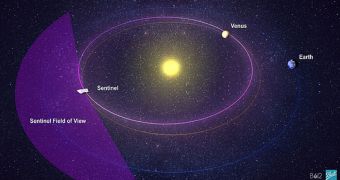As the recent close flybys have demonstrated, asteroids can zip past our planet with only a few moments' notice, and this does not sit well with astronomers. While the recent incidents did not pose any danger, they did emphasize the need to build a comprehensive early-detection system.
This is precisely what investigators from the Stanford University are doing, under the supervision of aeronautics and astronautics professor, Scott Hubbard. The main role of the future Sentinel Space Telescope will be to detect incoming near-Earth objects (NEO) that may be dangerous to the planet.
Astronomers want to be able to detect these objects early on, so that a plan to deflect them if need be could be set in motion in time. This means that prospectively dangerous space rocks will have to be detected at least a year ahead of making their final approach.
According to several infrared studies conducted on NEO thus far, at least 8,000 such objects exist in orbits intersecting Earth's, and tens of thousands more await discovery. At this point, we have no space telescope dedicated to looking for potential hazards that may affect the planet.
Granted, not all asteroids are dangerous. Some would only cause localized destruction if they hit, others would cause tsunamis, and others still would be harmless. But there are those at least a kilometer (0.6 miles) in diameter that could cause another global extinction event.
“We should be able to establish orbits well enough that we can predict where the asteroids will be in 50 to 100 years,” Hubbard explains. He says that the SST is the first privately funded deep space mission.
Details of the telescope and its mission were announced on Thursday (June 28) at a meeting of the California Academy of Sciences, held in San Francisco. The SST will be funded by the B612 Foundation, with support from the American space agency.
The mission will launch on a Falcon 9 rocket, provided by Hawthorne, California-based Space Exploration Technologies Corporation (SpaceX). Takeoff will occur within 5 to 6 years, experts say.
“The B612 Sentinel mission extends the emerging commercial spaceflight industry into deep space – a first that will pave the way for many other ventures. Fifty years ago, space was the exclusive province of governments. Now we're reaching a tipping point,” Hubbard concludes.

 14 DAY TRIAL //
14 DAY TRIAL //